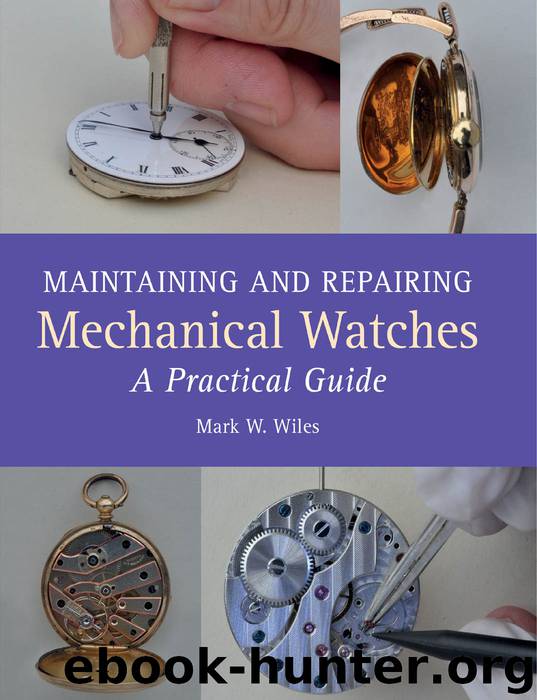Maintaining and Repairing Mechanical Watches by Mark W Wiles

Author:Mark W Wiles
Language: eng
Format: epub
ISBN: 9781785001567
Publisher: Crowood
The two most common types of balance in modern and antique watches are the bi-metallic balance, and the plain/annular balance.
Bi-metallic Balance
Fig. 159: Bi-metallic balances. Image 1: (A) Brass rim of the balance wheel. (B) Steel inner rim of the balance wheel. Image 2: (A) Stud (fixing point of the spring). (B) Cover coil spring. (C) index pins. A watch with an over-coiled balance spring is best left to more experienced watch repairers, as these are very easily damaged.
A bi-metallic balance is where the rim of the balance has been made of two strips of metal (one brass and one steel).This outer rim is also cut through either side of the balance’s centre crossing, so that the balance now has two semi-circular arms. The theory behind the balance wheel is that brass has a bigger coefficient of expansion than that of steel, so as the two bands of metal are joined together, this causes a natural bending effect as the two metals expand and contract at different rates. In cold weather, this would cause the balance rim to bend outwards, cancelling out the natural shrinking effect of the balance wheel. The opposite occurs in hot weather, as the balance rim bends inwards, compensating for the expansion of the whole balance.
Plain Balance or Annular Balance
Download
This site does not store any files on its server. We only index and link to content provided by other sites. Please contact the content providers to delete copyright contents if any and email us, we'll remove relevant links or contents immediately.
Periodization Training for Sports by Tudor Bompa(8105)
The Body: A Guide for Occupants by Bill Bryson(4898)
The MacArthur Bible Commentary by John MacArthur(4690)
The Sports Rules Book by Human Kinetics(4224)
What It Really Takes to Get Into Ivy League and Other Highly Selective Colleges by Hughes Chuck(3650)
Marijuana Grower's Handbook by Ed Rosenthal(3592)
The Sprouting Book by Ann Wigmore(3516)
The Martian by Andy Weir(3255)
Salt, Fat, Acid, Heat: Mastering the Elements of Good Cooking by Nosrat Samin(3086)
The Bread Bible by Rose Levy Beranbaum(2977)
Harry Potter 4 - Harry Potter and The Goblet of Fire by J.K.Rowling(2953)
Sapiens and Homo Deus by Yuval Noah Harari(2951)
Classic by Mary Berry(2921)
The Marketing Plan Handbook: Develop Big-Picture Marketing Plans for Pennies on the Dollar by Robert W. Bly(2908)
Martha Stewart's Baking Handbook by Martha Stewart(2754)
The Plant Paradox by Dr. Steven R. Gundry M.D(2518)
Screenplay: The Foundations of Screenwriting by Syd Field(2514)
50 Economics Classics by Tom Butler-Bowdon(2489)
The Cambridge Grammar Of The English Language by Rodney Huddleston Geoffrey K. Pullum(2361)
